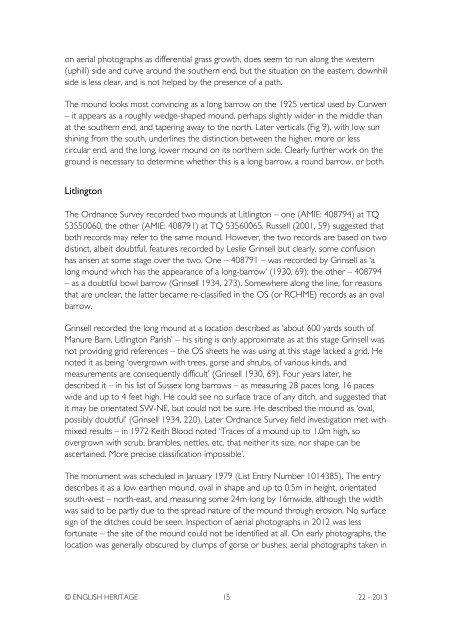Aerial Investigation and Mapping Report - English Heritage
Aerial Investigation and Mapping Report - English Heritage
Aerial Investigation and Mapping Report - English Heritage
You also want an ePaper? Increase the reach of your titles
YUMPU automatically turns print PDFs into web optimized ePapers that Google loves.
on aerial photographs as differential grass growth, does seem to run along the western(uphill) side <strong>and</strong> curve around the southern end, but the situation on the eastern, downhillside is less clear, <strong>and</strong> is not helped by the presence of a path.The mound looks most convincing as a long barrow on the 1925 vertical used by Curwen– it appears as a roughly wedge-shaped mound, perhaps slightly wider in the middle thanat the southern end, <strong>and</strong> tapering away to the north. Later verticals (Fig 9), with low sunshining from the south, underlines the distinction between the higher, more or lesscircular end, <strong>and</strong> the long, lower mound on its northern side. Clearly further work on theground is necessary to determine whether this is a long barrow, a round barrow, or both.LitlingtonThe Ordnance Survey recorded two mounds at Litlington – one (AMIE: 408794) at TQ53550060, the other (AMIE: 408791) at TQ 53560065. Russell (2001, 59) suggested thatboth records may refer to the same mound. However, the two records are based on twodistinct, albeit doubtful, features recorded by Leslie Grinsell but clearly, some confusionhas arisen at some stage over the two. One – 408791 – was recorded by Grinsell as ‘along mound which has the appearance of a long-barrow’ (1930, 69); the other – 408794– as a doubtful bowl barrow (Grinsell 1934, 273). Somewhere along the line, for reasonsthat are unclear, the latter became re-classified in the OS (or RCHME) records as an ovalbarrow.Grinsell recorded the long mound at a location described as ‘about 600 yards south ofManure Barn, Litlington Parish’ – his siting is only approximate as at this stage Grinsell wasnot providing grid references – the OS sheets he was using at this stage lacked a grid. Henoted it as being ‘overgrown with trees, gorse <strong>and</strong> shrubs, of various kinds, <strong>and</strong>measurements are consequently difficult’ (Grinsell 1930, 69). Four years later, hedescribed it – in his list of Sussex long barrows – as measuring 28 paces long, 16 paceswide <strong>and</strong> up to 4 feet high. He could see no surface trace of any ditch, <strong>and</strong> suggested thatit may be orientated SW-NE, but could not be sure. He described the mound as ‘oval,possibly doubtful’ (Grinsell 1934, 220). Later Ordnance Survey field investigation met withmixed results – in 1972 Keith Blood noted ‘Traces of a mound up to 1.0m high, soovergrown with scrub, brambles, nettles, etc, that neither its size, nor shape can beascertained. More precise classification impossible’.The monument was scheduled in January 1979 (List Entry Number 1014385). The entrydescribes it as a low earthen mound, oval in shape <strong>and</strong> up to 0.5m in height, orientatedsouth-west – north-east, <strong>and</strong> measuring some 24m long by 16mwide, although the widthwas said to be partly due to the spread nature of the mound through erosion. No surfacesign of the ditches could be seen. Inspection of aerial photographs in 2012 was lessfortunate – the site of the mound could not be identified at all. On early photographs, thelocation was generally obscured by clumps of gorse or bushes; aerial photographs taken in© ENGLISH HERITAGE 15 22 - 2013

















